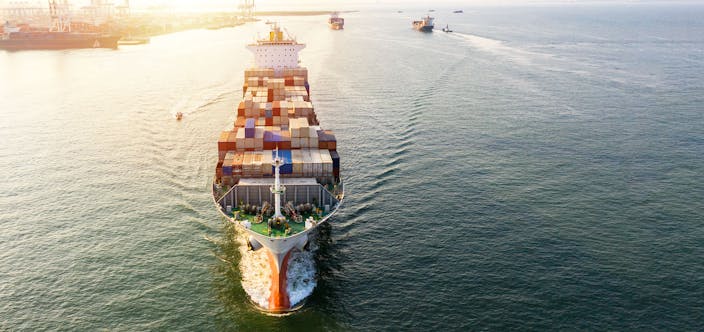The Future of Fuels: Navigating the Transition to Cleaner Energy
As the shipping industry faces increasing pressure to reduce its environmental impact, the focus has shifted towards innovative, sustainable fuel sources. With rising regulations and a global push to decarbonise, finding alternatives to traditional marine fuels has become not just an environmental goal but an economic and technological necessity. This critical transition was the focus of our recent webinar, where industry leaders shared their insights into the challenges and opportunities of future fuels, including hydrogen, biofuels, synthetic fuels, and ammonia.
Participants:
- Charlotte Røjgaard, Global Marine Fuels Director at Bureau Veritas
- Peter Björkborg, Head of Energy Transition at Stena Teknik
- Lina Barsøe, Head of Decarbonization Pathways at DFDS
- Mathias Mattson, Chartering Manager at Meriaura
Moderator:
Anton Mansnerus, Claims Executive at Alandia
Key Points: The Future of Fuels
- Urgency for Change: The maritime sector is under pressure to decarbonise, with the International Maritime Organization (IMO) setting strict targets for emission reductions. Traditional fuels are becoming less viable due to environmental and economic pressures.
- Infrastructure and Collaboration: Building the necessary infrastructure and fostering collaboration across the industry are crucial for the success of future fuels. These factors are key to overcoming regulatory, technical, and logistical barriers.
- Regulatory Development: Many future fuels, such as ammonia, are still subject to evolving regulations. This makes long-term planning difficult, and clearer frameworks are needed to guide industry investment.
- A Mixed-Fuel Future: The transition will likely involve a mix of fuels rather than a single solution, with adaptability and flexibility being crucial for long-term sustainability in the shipping industry.
A Growing Urgency for Change
The maritime sector is one of the largest contributors to global carbon emissions, and with the International Maritime Organization (IMO) setting ambitious targets for emission reductions, the search for cleaner energy alternatives has never been more urgent. Traditional fuels like heavy fuel oil and marine diesel are coming under scrutiny, as industries recognise the long-term financial and operational risks of relying on carbon-heavy operations.
Among the most promising candidates are hydrogen, ammonia, and biofuels, each offering unique advantages and challenges for global shipping, transportation, and industrial processes.
Charlotte Røjgaard, Global Marine Fuels Director at Bureau Veritas, opened the webinar with a broad overview of the current landscape, emphasising that the industry is at a pivotal point. She stressed that fuel choices made today will have long-lasting impacts on not only emissions but also operational efficiency and compliance with increasingly stringent environmental standards.
“We must carefully evaluate which fuels will carry us forward,” Charlotte explained, underscoring the need for balance between innovation and practicality. The transition to sustainable fuels is not a simple shift—it requires an understanding of the trade-offs and technical complexities that come with each fuel option.
Hydrogen: The Fuel of the Future?
One of the most discussed fuels in the green energy space is hydrogen. Often referred to as the “fuel of the future,” hydrogen offers immense potential as a clean energy source, especially in sectors like transportation and shipping. It can be used to power fuel cells, producing only water as a by-product, making it a zero-emission fuel.
However, as Peter Björkborg, Head of Energy Transition at Stena Teknik, pointed out, there are still significant challenges to overcome before hydrogen can be widely adopted. Infrastructure development is one of the key hurdles—there is a need for robust hydrogen production, storage, and distribution networks to support its widespread use. Peter shared insights from Stena’s own experiences, particularly with methanol, another promising fuel.
“Methanol is not only a transitional fuel but also a potential long-term solution for the shipping industry,” he noted. Methanol is often praised for its versatility and the fact that it can be produced from a variety of renewable sources, making it an attractive option for decarbonising the maritime sector. But like hydrogen, methanol requires significant investment in new infrastructure and technology to scale effectively.
Ammonia: The Next Frontier?
Ammonia is another alternative gaining attention, particularly for maritime applications. Unlike hydrogen, ammonia can be easily stored and transported in liquid form, making it a practical choice for long-haul shipping. It’s also an energy-dense fuel, which is crucial for ships covering vast distances.
Lina Barsøe, Head of Decarbonisation Pathways at DFDS, presented on the feasibility of ammonia as a future fuel and the hurdles that remain. Regulatory frameworks for ammonia-fuelled vessels are still being developed, and there are significant technical challenges in ensuring that these ships can operate safely and efficiently.
“We’re actively working towards solutions that meet both environmental standards and operational needs,” Lina said, reflecting the delicate balance between innovation and regulation. While ammonia offers a promising future, its toxic nature requires specialised handling and robust safety measures, adding layers of complexity to its adoption.
Yet, for industries like shipping, where decarbonisation is crucial, ammonia could be a viable solution in the coming decades. Lina’s presentation made it clear that while ammonia is not ready for immediate deployment at scale, the industry is laying the groundwork for its future role.
Biofuels: A Practical Approach
For some industries, biofuels offer an immediate and practical solution to reduce emissions without requiring significant modifications to existing infrastructure. Mathias Mattson, Chartering Manager at Meriaura, discussed the company’s ambitions in using biofuels within their operations, highlighting the practical experiences they have gained in this area.
“Biofuels offer a viable alternative for companies looking to reduce their carbon footprint,” Mathias explained. Although biofuels are not fully carbon-neutral, they can provide a significant reduction in emissions compared to conventional marine fuels. Their role in the transition to future fuels is one of practicality and immediacy, allowing for a smoother integration into current systems.
Overcoming Barriers: Infrastructure and Collaboration
One of the key themes that emerged throughout the webinar was the importance of infrastructure and industry collaboration in making future fuels viable. Whether it’s hydrogen, ammonia, or biofuels, the need for widespread, reliable infrastructure to produce, transport, and store these fuels cannot be overstated.
An audience member asked about the level of cooperation within the industry and whether companies were sharing insights about future fuel types. The speakers agreed that collaboration would be critical to advancing the use of alternative fuels, especially given the complex regulatory and safety challenges that lie ahead.
Another key issue discussed was regulation. Many of the emerging fuels still lack clear regulatory frameworks, which makes long-term planning difficult. As one participant asked, “Is it possible to build an ammonia-driven vessel with today’s regulations?” While some standards are in place, much of the regulation around future fuels is still in development, creating uncertainty for companies looking to invest in new technologies.
The Road Ahead
As the webinar drew to a close, one key takeaway was clear: the future of fuels will likely involve a mix of options rather than a single solution. As Peter Björkborg remarked, “It’s not just about finding the perfect fuel, but rather about building a system that allows for flexibility and adaptability.”
Nuclear power was also raised as a potential long-term solution for decarbonising large-scale industries like shipping, but the consensus was that more research and development is needed before it becomes a viable alternative.
Ultimately, the transition to future fuels is about more than just reducing emissions—it’s about rethinking how we produce, store, and use energy. The choices made today will shape the environmental and economic future for decades to come. And while the path ahead is complex, one thing is certain: the journey towards cleaner, more sustainable fuels is already underway, and there is no turning back.
As the speakers urged, now is the time for action—whether through continued research, investment in new infrastructure, or industry-wide collaboration. The future of fuels is within reach, but only if we collectively commit to making it a reality.


